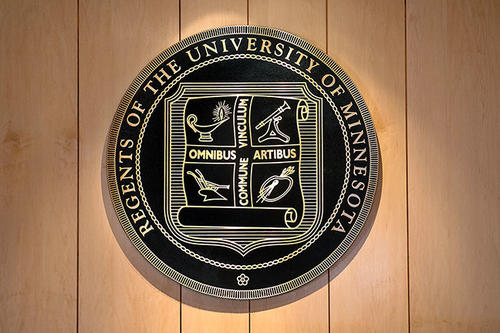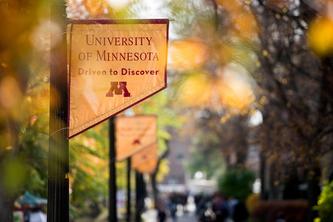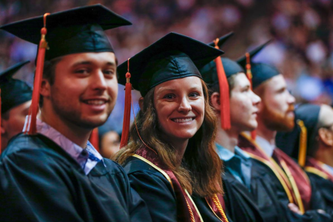
While University of Minnesota Professor Jian-Ping Wang develops transformative technology with some of the smallest molecules known to humanity, his Center for Spintronic Materials, Interfaces and Novel Architectures (C-SPIN) continues to receive significant financial support from business and industry (B&I) sponsors. Wang’s center and many other projects across the institution received more than $80 million in B&I funding in fiscal year 2016, up 3.6 percent ($2.8 million) from last year, marking the highest total in U of M history.
“B&I support has accounted for more than 10 percent of all externally-funded research at the U of M over the past two years and is gaining in importance as federal funding continues to decline,” said outgoing Vice President for Research Brian Herman in his annual report on University research. He presented to the U of M’s Board of Regents today.
Herman, who is returning to the faculty, pointed to several significant public-private partnerships contributing to sustained growth in B&I support: Minnesota Discovery Research and InnoVation Economy (MnDRIVE), a targeted research program supported by the state of Minnesota; the Minnesota Innovation Partnerships (MN-IP) program for licensing intellectual property; and the Corporate Engagement Workgroup, which manages and coordinates relationships with companies across the University’s many colleges and units.
In all, University researchers successfully competed for $788 million in externally-sponsored research awards in FY16, the highest total ever (when one-time American Recovery and Reinvestment Act funding is excluded). These awards continued a decade-long trend of diversifying the University’s research portfolio, with federal funds’ share shrinking below 60 percent of the total, and non-federal sources, including B&I, driving a 9 percent inflation-adjusted increase in funding between FY07 and FY16.
According to the National Science Foundation survey of research and development — the most accurate list of research expenditures in the U.S. — the University remains 8th among public research institutions, posting more than $880 million in research expenditures in FY15, the latest year for which data is available. The University’s Twin Cities campus remained third in expenditures among Big Ten institutions behind only the University of Michigan and the University of Wisconsin-Madison.
The vice president for research also oversees technology commercialization and economic development offices, and these efforts continued to thrive in FY16. The University launched a record 17 startup companies in FY16, and passed a milestone of 100 startups since FY06. The Office of University Economic Development increased activities with large and small companies, as well as community partners across Minnesota.
Vice President Herman has also overseen major changes recommended by an outside review panel last year to enhance the University’s human research protection program. He thanked the researchers and administrators who contributed to this work, which is nearing the end of its implementation phase, and urged careful attention to its continuation.
“It is not enough that our research has the potential to save lives, or, outside the field of research involving human participants, that it has the potential to improve our lives, our society or even save our planet. The public also expects that our research processes are ethical; they expect to be shown how this work connects with their lives and they want to be actively included in the planning, execution, analysis and benefit of the research they participate in,” Herman said.
With diminished federal funding for university research and public skepticism over universities’ missions, values and impact, Herman said, the University needs to engage with its community and partners to create both social and economic value at the same time.
“I feel encouraged that the University can meet the challenges of this changing funding landscape,” said Herman. “We have many assets in our people and infrastructure. If we can shift from ‘the way we’ve always done it’ toward a nimbler and more innovative culture, we can be a leader in adapting to the new research reality of constrained resources.”
Advancing the Medical School
University Medical School faculty and staff received research awards totaling $181.8 million last year, the largest amount of any unit at the institution, tackling a variety of health topics, including Alzheimer’s, Parkinson’s, cancer and brain conditions, among others.
In a report on progress on the school’s strategic plan, research and scholarship achievements were outlined by Dr. Brooks Jackson, dean of the Medical School and vice president for health sciences, in a report on progress on the school’s strategic plan. Strategic Vision 2025 calls for a “world class medical school advancing health at the forefront of learning and discovery.”
Jackson also discussed:
- hiring new leaders for the Departments of Medicine, Psychiatry and the Duluth campus, as well as the Medical Discovery Team focused on health equity and rural health access;
- strengthening curriculum and learning, while freezing tuition for a third straight year and increasing scholarship funding;
- growing clinical care revenue, services and quality with University of Minnesota Health and U of M Physicians partners; and
- exploring opportunities to provide care, training and research to system partners around the state.
In addition to a continued focus on plan goals, Jackson and University leaders will also seek further support from the state legislature for a new Health Sciences Education facility.
The Board also:
Reviewed the make-up of the UMTC undergraduate student body, which features the most academically qualified first-year class in history, and the largest since 1970. More detail, including increased retention and graduation rates, can be found in this press release.
Affirmed the future location of the Twin Cities recreation sports bubble and fields, which will be displaced by the Gopher Athletics Track and Field facility. The bubble and fields will be relocated to the current site of the Electric Steel and Mathieson Elevators, which were approved to be demolished in October.
Discussed the 2016 University Plan, Performance and Accountability report, which serves as a reference guide for the institution’s progress toward strategic goals. The draft report can be found in the Board’s docket materials. A final report is expected in February.
Accepted a report showing the University exceeded FY16 legislative performance goals in all five areas, thus releasing roughly $28 million in performance-based state funding that was held contingent on meeting at least three of the five goals. Among the system-wide results were increases in four-year graduation rates for students of color, total number of undergraduate Science, Technology, Engineering and Math degrees and licensing disclosures.
Approved the appointment of Michelle Behr, Ph.D., as the new Chancellor of the Morris campus. Behr will begin her role on Feb. 6, 2017 and succeeds Jacqueline R. Johnson, who is retiring after more than 10 years leading the campus.
Read President Kaler’s report to the Board.
The Board will meet again on Feb. 9-10, 2017. For more information, please visit the Regents website.
- Categories:
- Campus Affairs





